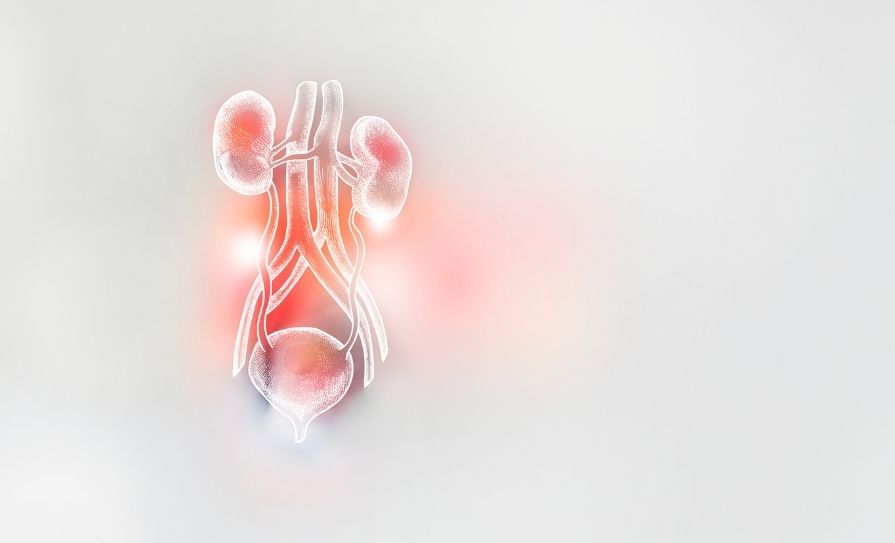Donna Cosgrove MPSI looks at the challenges of treating and managing urinary tract infections
Introduction
A lower urinary tract infection (UTI) is an infection of the bladder, usually caused by bacteria from the gastrointestinal tract entering the urethra and causing infection and associated inflammation in the urinary tract.1 In most cases, antibiotic treatment is required, but some acute, uncomplicated lower UTIs in non-pregnant women may be self-limiting. Escherichia coli is the most common culprit (up to 95 per cent of cases), followed by Staphylococcus saprophyticus (up to 10 per cent of cases).
Pyelonephritis, when the lower UTI ascends and leads to an upper RTI, is the most common complication, although most cases fortunately do not lead to residual kidney damage. More severe complications can occur in pregnancy, even with asymptomatic bacteriuria: Renal impairment/failure, septicaemia, and preterm labour. Around 20 per cent of men are affected by lower UTIs in their lifetime, which may lead to prostatitis. In children, UTIs may lead to renal scarring, but this is due predominantly to acute pyelonephritis rather than lower UTI.
UTIs affect up to 50 per cent of women, with recurrent UTIs (?3 UTIs in 12 months) estimated to affect about 3 per cent of women each year.2 These can significantly impact mental and physical quality of life. Higher levels of depression, stress, anxiety, sexual dysfunction, and physical disability are reported by women with recurrent UTI.3
Bacteria in the bladder
The healthy bladder is not sterile: Urine contains a diverse microbial community even in healthy, asymptomatic individuals. This urinary microbiome is thought to perform critical functions in bladder homeostasis, with potential roles in the maintenance of urothelial integrity, protection against infection, regulation of neurotransmission, and promotion of normal immune function.4 In a healthy bladder, symbiotic microbiota perform these functions. In patients with bladder dysfunction, a dysbiotic urinary microflora alters bladder function and results in pain.
The recognition of this established symbiotic microbiome within the healthy genitourinary tract has led to some uncertainty about our previously established diagnostic and management criteria of UTI. No consensus exists for a strict definition of UTI in terms of the bacterial colony-forming unit- based thresholds that define infection by standard urine culture. This issue is compounded by the fact that urinary bacteria can be detected in the urine of nearly all individuals, even those who are asymptomatic. According to the strict definition, this meant that all people have “bacteriuria”.
Recurrent UTI
A UTI is resolved typically with antibiotic treatment; however, in susceptible individuals, epithelial damage can result in an increased level of T lymphocyte (Th2) response. This can lead to reduced resistance against both exogenous and endogenous bacteria, leading to a cycle of recurring UTI.3
Recurrent or persistent lower urinary tract symptoms are not, however, always due to recurrent UTI: There are many conditions that can cause similar symptoms.5 Clinical examination is important to identify or exclude dermatological conditions affecting this area. Alternative diagnoses may include:
- Sexually transmitted infections;
- Postmenopausal atrophic vaginitis;
- Vulvovaginal candidiasis;
- Vulvar lichen sclerosus, psoriasis, or other dermatological conditions;
- Vulvodynia.
Management
The HSE recommends initially providing advice on behavioural treatments for non-pregnant women with symptoms of a recurrent lower UTI. Research evidence for these measures is limited but, anecdotally, people find them effective. They include:
- Increased fluid intake;
- Avoiding potential irritants in the vulval area, where skin is easily irritated. These include soaps, perfumes, talc, cleansing wipes, disinfectants, and washing too frequently (once a day is usually enough). Plain water or an emollient cream can be used to wash. In cases where incontinence is an issue, a barrier cream/ointment may be useful;
- Post coital voiding;
- Not delaying urination;
- Avoiding constipation;
- Wiping from front to back;
- In peri or postmenopausal individuals, vaginal oestrogen may help with UTI symptoms;
- The HSE includes D-mannose (2g) once daily as an option for UTI prophylaxis. This prevents bacterial adhesion to urothelial cells, and has been shown to prevent recurrent UTIs, although a Cochrane review on D-mannose for prevention or treatment of UTIs found available evidence limited and of poor quality.6 It may also interfere with blood sugar levels in diabetics;
- Methenamine hippurate (1g 12 hourly) is also suggested as a possible prophylactic treatment. It works as a urinary antiseptic, producing formaldehyde, which prevents bacterial growth while also avoiding bacterial resistance.7 It has the advantage of also being GMS (medical card) reimbursable.5 As is the case with antimicrobial prophylaxis, de-prescribing should be considered after three-to-six months;
- There is no evidence for either alkalinising agents or cranberry products in treating lower UTI;6
- Some guidelines include recommendations for cranberry products for recurrent UTI prophylaxis2 (although this is not recommended by the HSE).
General advice on self-care should be offered to all people with lower UTI symptoms,1 ie:
- Use paracetamol or ibuprofen if required for any pain;
Recurrent or persistent lower urinary tract symptoms are not, however, always due
to recurrent UTI
- Drink plenty of fluids to avoid dehydration, which can itself be a driving factor in causing UTIs.
For non-pregnant women, a back- up antibiotic prescription should be considered (for use if symptoms do not start to improve within 48 hours, or worsen) or else an antibiotic prescription for immediate use, taking into account the symptom severity, risk of complications (ie, increased risk of complications in people with structural/functional abnormalities in the genitourinary tract/immunosuppression), and patient preference.
Pregnant women, men, and children under 16 with lower UTIs should be prescribed an antibiotic immediately. Ideally, a midstream urine sample should be sent for culture, with antibiotic choice reviewed when results are available. Pregnant women – even with asymptomatic bacteriuria – should also be issued a prescription for an appropriate antibiotic immediately.
If, in anyone, symptoms do not start improving within 48 hours of starting the antibiotic, further medical advice should be sought.
Management with antimicrobials
- The shortest course likely to be effective should be prescribed in order to reduce antimicrobial resistance and adverse effects.1 Generally, in non-pregnant women, this is three days, although longer may be required in persistent or recurrent cases. Three-day courses were not found to be significantly different to longer courses (five-to-10 days) of any antibiotic in preventing short- or long-term symptomatic failure, short-term bacteriological failure, or the development of pyelonephritis. Furthermore, women taking a three-day course of antibiotics reported significantly lower rates of side-effects compared with a five- or 10-day course.
- Findings are similar for older women with a lower UTI. There is no advantage of a seven-to-10 day compared to a three-to-six-day course. Three days maximum should be required routinely.
- For pregnant women (either symptomatic or asymptomatic bacteriuria), a seven-day course of antibiotics is recommended because the risk of harm from a UTI is greater in pregnant women compared to non- pregnant women.
- A seven-day course is recommended for men with lower UTI, again due to increased risk of complications from UTIs.
- A three-to-seven-day course of antibiotics is sufficient for children and young people with lower UTI.
- Diarrhoea as a side-effect of antibiotics occurs in between 2 and 25 per cent of people taking antibiotics, depending on the choice of drug.
- Single-dose (post-coital, where this is an identified trigger), or continuous antimicrobial prophylaxis can be effective, however, there are always risks of side-effects.5 Nitrofurantoin long term is associated with liver damage, pulmonary fibrosis, and peripheral neuropathy.
- All antibiotics are linked with a risk of C.difficile infection.
- All prescriptions for antimicrobial prophylaxis should be reviewed after three-to-six months, even if started by a specialist. HSE guidance cautions that there is limited benefit after this time, but an increased risk of harm. More detailed information on de-prescribing is available on the HSE antibiotic prescribing website.
- There may be a benefit to provision of ‘standby’ antibiotics for UTIs.
- Assuming that susceptibility results indicate sensitivity:
- Nitrofurantoin (100mg as single dose prophylaxis, 50 to 100mg at night as continuous prophylaxis) or;
- Trimethoprim (200mg single dose, 100mg at night as continuous) are first-line choices;
- Second-line options are amoxicillin or cephalexin.
- Nitrofurantoin should be used cautiously in people with any renal impairment, and avoided at term at pregnancy, as it may lead to neonatal haemolysis.1 Trimethoprim (a folate antagonist) is considered to have a teratogenic risk in the first trimester, and its use is contraindicated in pregnancy by its manufacturer.
- Medication adherence – particularly with antibiotics that require frequent dosing or longer duration – is an issue worth taking into consideration with antibiotic choice.
- About 10 per cent of people say that they have a penicillin allergy, usually due to the development of a skin rash that occurred while taking the drug as a child. Of these people, fewer than 10 per cent are truly allergic to penicillin.
Future treatment
A sublingually-administered vaccination for UTIs, MV140 (Uromune), has been developed. This contains heat- inactivated bacteria (selected strains of Escherichia coli, Klebsiella pneumoniae, Enterococcus faecalis, and Proteus vulgaris), and is administered once daily (two sprays under the tongue) for three months. This stimulates production of antibodies and activates dendritic cells (a type of antigen presenting cell) to produce T helper (Th) 1, Th17, and IL-10, ultimately leading to anti-inflammatory T-cell responses in secondary lymphoid organs, and the bladder itself.
In a study of 57 women2 with a history of recurrent UTIs, MV140 reduced UTI incidence, with a 75 per cent reduction in UTIs over the nine-month period post-vaccination. Another retrospective study, presented in 2024, found that 54 per cent of vaccinated people remained UTI-free nine years after vaccination, with no notable side-effects.8 The vaccination, a pineapple-flavoured spray that may be provided by GPs as a three-month course, is not currently licensed by the European Medicines Agency. It is, however, available in some other countries through, ie, early access programmes, including the UK, under special circumstances.
References
1. National Institute for Health and Care Excellence. (2018). Urinary tract infection (lower): Antimicrobial prescribing. Prescribing. Available at: www.nice.org.uk/guidance/ ng109/resources/urinary-tract-infec- tion-lower-antimicrobial-prescrib- ing-pdf-66141546350533.
2. Nickel JC, Kelly KL, and Griffin A. (2023). MV140 sublingual vaccine reduces recurrent urinary tract infec- tion in women: Results from the first North American clinical experience study. Canadian Urological Asso- ciation Journal, 18(2), 25. Available at: pmc.ncbi.nlm.nih.gov/articles/ PMC10841562/.
3. Nickel JC and Doiron RC (2023). An effective sublingual vaccine, MV140, safely reduces risk of recurrent urinary tract infection in women. Pathogens, 12(3), 359. Available
at: pmc.ncbi.nlm.nih.gov/articles/ PMC10052183/.
4. Ackerman AL and Chai TC (2019). The bladder is not sterile: An update on the urinary microbiome. Current bladder dysfunction reports, 14, 331- 341. Available https://pmc.ncbi.nlm. nih.gov/articles/PMC7328282/.
5. Health Service Executive. (2023). Recurrent UTI in adult, non-pregnant females. Available at: www.hse.ie/eng/services/list/2/gp/antibiotic-pre- scribing/conditions-and-treatments/ urinary/recurrent-uti-in-adult-non- pregnant-females/.
6. Cooper TE, Teng C, and Howell M. (2022). D?mannose for pre- venting and treating urinary tract infections. Cochrane Database of Systematic Reviews. Available at: www.cochranelibrary.com/cdsr/ doi/10.1002/14651858.CD013608. pub2/full.
7. Chwa A, Kavanagh K, and Linnebur SA. (2019). Evaluation of methenamine for urinary tract infection prevention in older adults: A review of the evidence. Therapeutic advances in drug safety, 10, 2042098619876749. Available at: pmc.ncbi.nlm.nih.gov/articles/ PMC6759703/#:~:text=Methenam- ine per cent20has per cent20been per cent20proposed per cen- t20as,growth per cent20while per cent20avoiding per cent20bacterial per cent20resistance.
8. National Health Service. (2024). Leading research for oral UTI vaccine carried out at Royal Berkshire NHS Foundation Trust. Accessed April 1st, 2025. Available at: www.royalberk- shire.nhs.uk/news/leading-research- for-oral-uti-vaccine-carried-out-at- royal-berkshire-nhs-foundation-trust.







